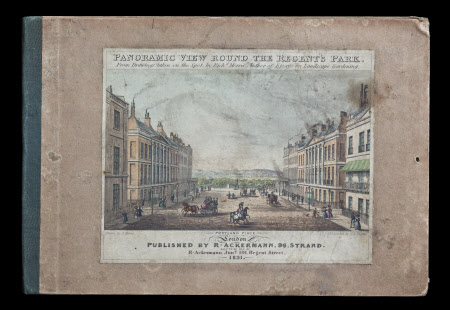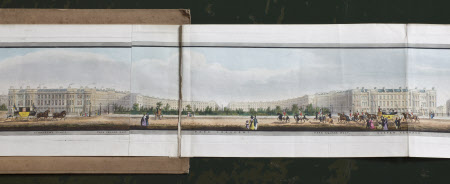Panoramic view round the Regent's Park. : From drawings taken on the spot. / By Richd. Morris, ...
Richard Morris
Category
Books
Date
1831
Materials
Place of origin
London
Order this imageCollection
Anglesey Abbey, Cambridgeshire
NT 3085719
Summary
Richard Morris, Panoramic View Round the Regent's Park, London: printed by R. Ackermann, 1831. Binding: Nineteenth-century quarter blue cloth, buff paper over boards; printed coloured pictorial title label on upper board; housed in protective quarter red morocco box, with binder's gilt stamp 'Robson and Co. Ltd. W1"; gilt title on spine of box: 'Panorama of Regent's Park. 1831'.
Full description
In 1787 the Irish-born painter Robert Barker took out a patent for a new type of painting which he called ‘la nature à coup d'oeil’. His technique for the representation of a 360-degree view of a landscape in correct perspective, mounted on the walls of a circular room, soon acquired the more concise name ‘panorama;, which in turn came to be used in its modern meaning of an all-round view. Barker's panorama of London, completed in 1792, was a great success with the public, and he swiftly built a huge rotunda in Leicester Square, in which was displayed a changing programme of paintings in a manner which enhanced their ‘trompe l'oeil’ qualities. The opening show of the fleet at Spithead was reputed to be so realistic that it made Queen Caroline seasick, and the panorama was soon established as a popular art form. It appealed to the romantic traveller who ascended towers and mountains in search of picturesque views, to patriots or armchair warriors who wanted to see the scenes of recent battles without risk or exertion, and to anyone who wanted to experience a familiar or unfamiliar view from a new viewpoint. Small-scale reproductions of panoramas were produced as souvenirs from their earliest days, and the strip panorama soon became an independent genre, though it could never hope to reproduce the overwhelming quality of the full-scale prototypes. These publications, sold concertinaed in folders or rolled in cylinders, had another ancestor in the form of the engraved representation of the triumphal procession, produced as far back as the sixteenth century. The novelty was that the strip panorama generally gave an all-round view, whereas a work such as the ‘La magnifique Entrée de Francois d'Anjou en so Ville dAnvers’ was purely linear. This particular example was produced by the firm of Ackermann (from which Rudolph had now largely retired) in 1831. The drawings were by Richard Morris, a fellow of the Linnean Society of London, otherwise known only for a set of ‘Essays on Landscape Gardening’, published in 1825. A pleasingly referential touch is the inclusion of the exterior of the Colosseum, which contained one of the most spectacular panoramas of all. This was an aerial view of London sketched from scaffolding atop St Paul's Cathedral in 1823-4 by the surveyor and artist Thomas Hornor (1785-1844) during restoration work. Ackermann had produced a series of aquatints illustrating the Colosseum and its panorama two years earlier, which portrays it as a pleasure dome worthy of Kubla Khan; it was demolished in 1875. Text adapted from William Hale's entry in ‘Treasures from Lord Fairhaven’s Library at Anglesey Abbey’, National Trust, 2013, cat. 36, pp. 114-7.
Bibliographic description
1 sheet ; obl. fol. Pencil numbers on pastedowns: "6780" (front) and "369" (rear). Provenance: Twentieth-century armorial bookplate, signed G.S. 1924: ‘Urban Huttleston Rogers Broughton’ [i.e.: Urban Huttleston Rogers Broughton, 1st Lord Fairhaven (1896-1966)]. Binding: Nineteenth-century quarter blue cloth, buff paper over boards; printed coloured pictorial title label on upper board; housed in protective quarter red morocco box, with binder's gilt stamp 'Robson and Co. Ltd. W1"; gilt title on spine of box: 'Panorama of Regent's Park. 1831'.
Provenance
Acquired by Huttleston Rogers Broughton, 1st Lord Fairhaven (1896-1966) and then bequeathed by him to the National Trust with the house and the rest of the contents in 1966.
Makers and roles
Richard Morris, artist Hughes, S. H. (Engraver), engraver (printmaker)
References
Mark Purcell, William Hale and David Person, Treasures from Lord Fairhaven’s Library at Anglesey Abbey, Swindon: National Trust; London: Scala Arts & Heritage Publishers, 2013., pp. 114-7


